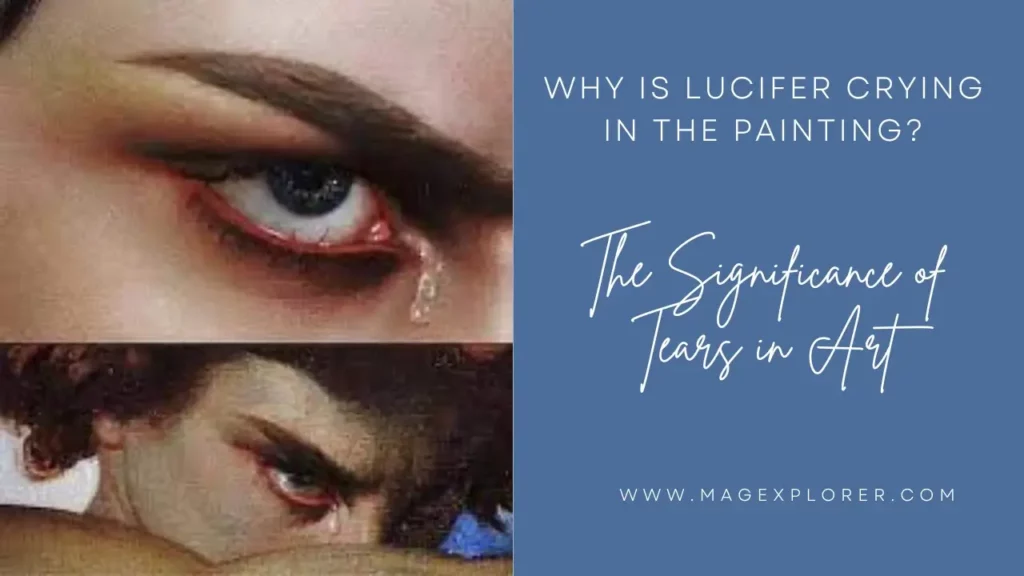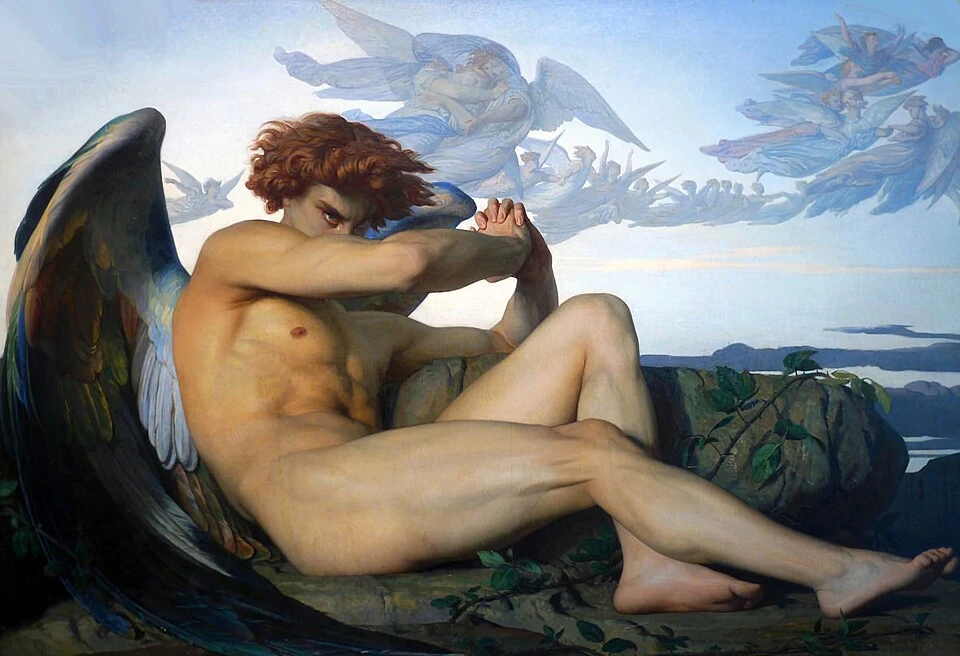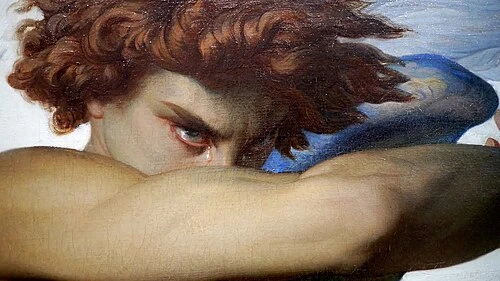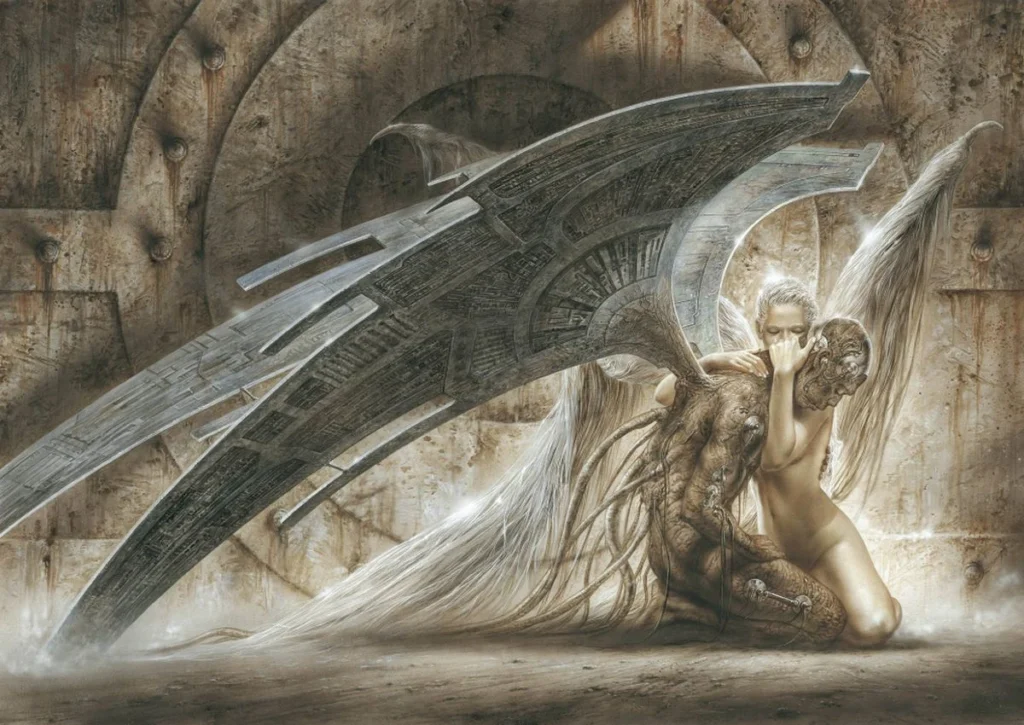Lucifer crying painting is an eye-catching artwork. It is highly emotive and symbolic and brings the audience to a different world.
This is the well known painting of Lucifer in tears called the fallen angel that was painted by Alexandre Cabanel.
The composition by Cabanel is now known as the work with emotional richness and technical skill. Lucifer has been caught in a state of deep turmoil with the aid of the painting.
The face of Lucifer with tear-streaks is a symbol of loss and regrets. He has a mixture of sadness, defiance, and anger on his face.
Light and shadow are used to boost the emotion. The portrayal by Cabanel refutes customary beliefs about Lucifer being the devil.
This painting can be regarded as a criticism of the duality of human nature. It calls the audience to sympathize with the case of Lucifer.
The painting has attracted a lot of analysis because of the emotional appeal of the artwork. It also still evokes the debates concerning good and evil.
Fallen Angel by Cabanel is an important art and theological work. It is a tribute to the strength of the art to trigger sympathy and contemplation.
The Origins of the Lucifer Crying Painting
The painting Fallen Angel by Alexandre Cabanel has an interesting history. Developed in the version of the Romanticism epoch of the 19 th century, it resembles the tendencies of art of these epochs. Romanticism focused on emotion, dramatic stories and the expression of imagination.
Fallen Angel was first shown by Cabanel at the Paris Salon of 1847. This famous art exhibition could easily include paintings of extreme emotional and visual nature. The picture soon triggered publicity over the powerful depiction of Lucifer.
The topic of Lucifer, the fallen angel, is not novel in art. It is an image of the effects of pride and ambition. This story has been the subject of interest to artists who have portrayed it in different ways to develop sophisticated topics.
The important aspects of the painting are:
- His heart broken and rebellious Lucifer.
- The intricate detail and realistic representation of emotions.
- The use of lights and shadows to emphasize the features of the faces of Lucifer.

The fact that Cabanel decided to show Lucifer crying gives this old theme some extra meaning. It offers a human aspect to a character that has been regarded as being evil. The origins of the painting can be traced back to a combination of mythological narration and personal expression that gives the viewers an idea what the artist saw in a classic story. With his work, Cabanel challenges us to experience aspects of loss, remorse and emotional ambiguity.
Alexandre Cabanel and the Creation of “Fallen Angel”
Alexandre Cabanel was a French painter with his technical brilliance and expressive style. He was born in 1823 and grew up as one of the most influential people in art in the 19 th century leaving an impression of his expressive works. His talent and his vision can be seen in his painting Fallen Angel which was painted when he was at the peak of his career.
The Fallen Angel is carefully designed by Cabanel in a way that makes it stimulate emotional feelings. The painting is a candid shot of Lucifer in a tender situation with a sorrowful look with a streaked face. The decision to make Lucifer cry was provocative and bold and defied the traditional image of Lucifer as a purely evil character.
The painting of Fallen Angel was carried out using a complex management of color and light to enrich the emotional aspect of the painting. Cabanel has adopted a wonderful style with gentle strokes of the brush and delicate palette. This is an effective play in light and shadow and it makes the face of Lucifer stand out and his sadness and inner conflict.

The Fallen Angel by Cabanel is the master piece of the art and narration. It is an indication of his skill to make complicated characters human enough to cause the audiences to stop and think. Cabanel challenges the viewers to view Lucifer as tragic and sympathetic, but not a symbol of darkness, through his interpretation. His new thinking still serves to inspire both artists and people who love art which makes him one of the most important figures in the history of art.
Examining The Emotional Effect: Why Is Lucifer Crying?
The work of the French artist Alexandre Cabanel titled Fallen Angel brings to reality a very touching emotional story. In the middle of it is Lucifer, whose face is crying. But what evokes such tears from this legendary fallen angel?
Tears of Lucifer according to the painting of Cabanel are a sign of certain regret and loss. This emotional gesture is opposed to the conventional portrayal of Lucifer as an insurrectionary. Rather, Cabanel provides a peep into the inner world of sorrow by Lucifer.
This representation makes the viewers think about the duality of the nature of Lucifer. He does not simply seem rebellious but seems weak as well. His melancholy eyes are indicative of having been in a reflective mood, having to deal with his own decisions and the consequence thereof.
Cabanel manages to increase the emotional effect because of the skillfulness with which he depicts his expression. The combination of anger, sadness and defiance is subtle. This subtle form of expression makes one sympathize with his situation.
The fact that Lucifer could be crying could be because:
- A sense of betrayal and isolation
- Regret over his rebellion against divine will
- Awareness of the consequences of his pride and ambition
- Longing to be redeemed and accepted.
These factors make up a painting with a deep emotional texture. The careful writing and appeal to the sense of emotion enable the reader to dwell on intricate ideas. These themes are related to human feelings like remorse, pride and redemption.
The work of art is not limited by its mythological subject but it is simply a story of the human condition. By means of this weeping Lucifer, Cabanel is able to make us think of our own weaknesses and how we can be open to others, even the most unlikely.
Symbolism and Artistic Expression in the Painting
The painting Fallen Angel by Alexandre Cabanel is a virtuosic work of symbolism and art. The work goes beyond the representation and explores the depths of the character of Lucifer. Such a considerate approach gives the art a deep context.
All the elements of the painting narrate the story of inner conflict and turmoil. The pose of and facial expression of Lucifer are critical. His face with the tears running down and tense pose shows a serious inner conflict. These artistic decisions are used to emphasize the emotional values of this image.
Cabanel employs different symbols in order to enrich the story. His light and shadow play underscores the duality of Lucifer- who is between heaven and hell. His fallen status is contrasted with his human-like emotions being shed light.
In fallen angel, symbolism aspects are:
- Wings: an indicator of a lost divine status.
- Chains: The sign of the subjugation of his decisions.
- Tears: This is a sign of repentance and missing redemption.

The colors used support the alienation and sadness. Low-level sounds create a depressing environment and make the audience enter the gloomy world of Lucifer. Cabanel’s expert use of color highlights the anguish and complexity within.
Finally, the painting is a very deep reflection about the duality of Lucifer. Using symbolic and artistic articulation, Cabanel calls the audience to uncover the underlying concepts of rebellion, regret, and redemption. Still vibrant in its many meanings, this tapestry is engaging and an inspiration to this day.
The Fallen Angel Motif in Art History
The imagery of the fallen angel has a venerable art history. It is an interesting reminder of the results of pride and ambition. This theme has continuously attracted artists, and it is addressed to the complicated human state of being.
Over the centuries, the fallen angel represented a number of concepts. It is not only a mirror of religious motives. It also addresses larger ideas of morality, redemption and inner conflict. This motif recurs and calls to reflection.
A significant number of artists have also painted fallen angels and each has put a twist on this. These interpretations differ much according to the context of cultures and individual experiences. Art works have different techniques and styles, which are employed to express the same underlying feelings.
Key aspects of the motif include:
- Protests or repentance
- Imagery showcasing loss and isolation
- A focus on the transition between light and darkness

These details render the theme of the fallen angel full and diverse. Such artists as Cabanel add a psychological twist to their creations and create a mythical character into a personal story. These themes are timeless and this is what makes the fallen angel still applicable in one way or another, across time and inspires new works. The motif is still discussed with a lot of depth with both art lovers and scholars through its multifaceted symbolism that has provided a lot of depth in the duality of humanity.
The Use of Light, Color, and Composition
In the Fallen Angel by Cabanel, the role of light and shadow is extremely important in expression of emotion. The light focuses on the tortured face of Lucifer and this brings out the emotional state of the character. This chiaroscuro makes this painting more dramatic.
Choice of color also plays a crucial role in this painting. Cabanel uses quite a low palette, with an accent on gloomy colors. The effect of these tones is sadness and loss, which strengthens the emotional attachment of the viewer.
Cabulosually, Cabanel knows how to lead the viewer around the scene. The figure of Lucifer is placed in the middle, dominating all the other elements. This tactical position accentuates his eminence and self-inconsistency.
The play of lines and forms also contributes to the effect of the composition. The fine outlines of the wings of Lucifer are contrasted with his rigid posture and these represent the conflict between strength and fragility. This is a artistic decision that enhances the emotional effect of the painting.
Cabanel uses light, color and composition in general to come up with a strong narrative. All these details are combined to present the suffering and emotional distress of Lucifer, which draws the imagination of the observer. These elements of detail allow the viewer to consider the painting a great piece of artistic expression, as the art of telling visual stories is very powerful.
Humanizing Lucifer: Challenging Traditional Views
The work of Alexandre Cabanel called Fallen Angel creates a new image of a Lucifer. This painting has been considered traditionally as the image of evil, but this aspect leads us to a second thought. Cabanel makes Lucifer more human by demonstrating him in a state of helplessness.
Cabanel underlines the nature of the character of Lucifer through his portrayal. His face looks like he has a lot of emotions, sadness to rebellion. These strata dispel the naive perception of Lucifer as a villain.
The painting raises the significant questions concerning what good and evil are. Through the point that Lucifer is a human being, one starts to think of the implications of moral judgment. It implies that even such notorious characters have similar feelings to ours.
Important aspects that make Lucifer a human being in the painting:
- Weep-drop streaked face Oriental woe.
- Defiant yet pained gaze
- Vulnerable posture
The work of Cabanel is a reminder of the duality of the mythological stories. He distorts the boundaries between hero and villain by portraying Lucifer as both sad and as a strong character. This description is a call to watch more attentively and see a kind of understanding in unlikely places. The delicate style of the painting provokes the discussion of the complex nature of the human identity and moral values.
The Enduring Legacy and Influence of the Painting
Fallen Angel by Alexandre Cabanel is one of the paintings that are analyzed by the art historians and amateurs. Its depiction of Lucifer crying has sparked countless interpretations. The use of emotion and craftsmanship also makes this painting interesting to this day.
Artists nowadays look up to the work of Cabanel. He uses light and shadow in a very powerful way and it has impact in modern representation of mythological and emotional subjects. The inner conflict depicted in the painting appeals to the audience.
The image of Lucifer by Cabanel makes it difficult to comprehend what is good and what is evil. The concepts of duality are reflected in the modern culture where the depths of human nature frequently get developed. The legacy of the painting is that it appeals to universal feelings.
The ghostly beauty of the piece makes the viewers experiment with human feeling and salvation. Neither has it lost popularity, as it is exhibited and discussed in art literature quite often. The Fallen Angel created by Cabanel is not just a painting but a time conversation.
The iconic work keeps influencing and making us think, which positions it firmly in the history of arts.
Read Also: Top 40 Heartbreaking Sad Romance Books
Frequently Asked Questions About the Lucifer Crying Painting
What is the “Lucifer crying painting”?
The “Lucifer crying painting” typically refers to Alexandre Cabanel’s artwork known as “Fallen Angel.” It is a well-known image with a weeping Lucifer.
Why is this painting famous?
The Fallen Angel by Cabanel portrays a highly emotional picture of Lucifer. It is well known by its combination of technical expertise and emotional description.
What is the representation of the painting?
The painting represents a battle, remorse, and the two sides of Lucifer. It gives a multifaceted image of a fallen angel, which elicits sympathy.
Who was Alexandre Cabanel?
Alexandre Cabanel was a renowned French artist of the 19 th century. He was known to be good at romanticism particularly in the work “Fallen Angel.”
Where can I see the painting?
The painting is kept at Musée Fabre, Montpellier, France. It is one of the major sights of people who are interested in classical art.
What is the contribution of the painting to the art of the modern world?
Cabanel’s use of emotion and light in “Fallen Angel” influences modern interpretations of mythological themes. It also dares artists to delve into more emotional stories in the art.
Conclusion: The Lasting Power of the Crying Lucifer
Fallen Angel by Alexandre Cabanel is a masterpiece which travels through time. The artwork still fascinates the viewers today through the image of a weeping Lucifer.
Its emotional richness and technical excellence have kept the art fans entertained. Complex emotions are demonstrated by the gaze of Lucifer and evoke a huge empathy in audiences.
This artwork makes a controversy of good and evil. It is challenging to morality and the essence of humanity because of the way they introduce Lucifer as a tragic figure.
The combination of light, color and symbolic imagery enables Cabanel to make sure that the masterpiece of Fallen Angel will live in the history of art. The classic appeal of it highlights the universal ideas of loss and redemption.

